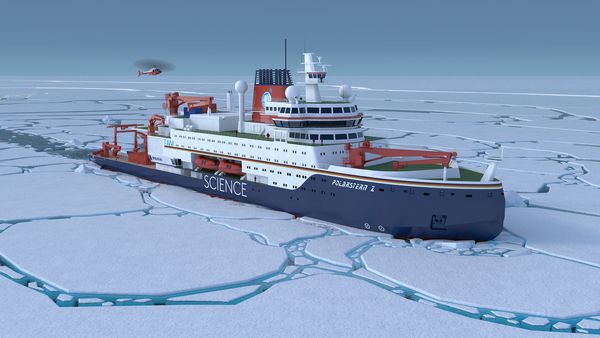Finnish propulsion expert Steerprop has been selected to power the new Polarstern, Germany’s next-generation polar research icebreaker, with a propulsion system designed to deliver exceptional reliability, minimal underwater noise, and long-term cost efficiency. The tailor-made solution supports the vessel’s demanding scientific mission in fragile polar environments and ensures high performance through cutting-edge predictive maintenance and proven ice-class technology—now scaled for unprecedented capability.
TKMS will build the new Polarstern for the Alfred Wegener Institute, Helmholtz Centre for Polar and Marine Research (AWI) and has selected the Finnish propulsion specialist Steerprop to supply the azimuth propulsion system for the new Polarstern, Germany’s next-generation polar research icebreaker. Steerprop’s solution was chosen for its exceptional reliability, ultra-low underwater radiated noise (URN), and advanced predictive maintenance capabilities—all vital to the success of long-term, uninterrupted polar missions in fragile ecosystems. In addition to these technical features, Steerprop’s unmatched propulsion expertise and proven ability to support complex, demanding vessel designs made it the clear choice. Steerprop’s polar track record—with azimuth propulsors on every third icebreaker in service in the world and without a single major overhaul in more than 15 years, also gave TKMS and AWI the confidence they needed.
Due to enter service in 2030, the new Polarstern will operate for up to 310 days a year in the Arctic and Antarctic, requiring a propulsion solution that supports extreme endurance, energy efficiency, and acoustic sensitivity. Built to Ice Class PC2, the vessel will be powered by two Steerprop SP 160 PULL ARC azimuth propulsors, the largest mechanical units of their kind ever built, each delivering 9 MW of power through a 4.8-meter diameter propeller. The specifications require holding a steady 3 knots through multiyear ice of up to 1.8 metres thick with 20 % snow cover.
For a vessel of this importance, technical performance alone isn’t enough,” said Riku-Pekka Hägg, CEO, Steerprop. “We’re proud to deliver a propulsion solution that ensures mission success while minimizing environmental impact, maximizing uptime, and optimizing total cost of ownership over the vessels’s lifetime.
Proven technology, scaled for new demands
While the SP 160 PULL ARC units represent a record in size, they are based on Steerprop’s well-proven mechanical propulsor platform, used widely in the icebreaking fleet. The thrusters are engineered for harsh ice conditions, offering mechanical dependability with modern automation for precise control in both icebreaking and station-keeping operations.

“The new Polarstern represents the next generation of research vessels with its high sustainable profile, and highest safety and standards,” said Yngvar Frodell, Project Director of the new Polarstern at TKMS. “With the selection of the complex propulsion system for the new Polarstern, we are ensuring that we meet our high requirements for reliability and environmental protection.”
Steerprop propulsors meet industry’s toughest URN standards
The new Polarstern will operate in ecologically sensitive regions where acoustic disturbance must be minimized. Meeting the most stringent URN requirements ever applied to a vessel of this class, the propulsors incorporate Steerprop’s unique design, engineering, and manufacturing standards—including a noise-optimized gearbox design and an integrated permanent magnet propulsion motor. These integrated features reduce radiated noise at its source, making the system ideal for acoustic research and minimally invasive marine operations.
Predictive maintenance for maximum uptime and cost efficiency
Given the vessel’s limited time in port and expected 30-year service life, predictive maintenance and reliability are central to mission success. Steerprop will supply its full Steerprop Care condition monitoring system, which continuously provides detailed data on propulsor health and performance. This empowers the operator to plan maintenance proactively, eliminating unnecessary part replacements and avoiding unplanned downtime—significantly reducing lifecycle costs.
Instead of changing components on a fixed schedule, the crew can make informed, data-driven decisions about when and what to service. That’s a smarter way to operate—and a big cost saver over decades, added Hägg.
A comprehensive polar propulsion partnership
Steerprop’s involvement goes beyond delivering the two main azimuth units. The company is also fully responsible for the hydrodynamic design of the vessel’s center shaft line propeller—ensuring optimal integration and performance across the entire main propulsion system. By taking full ownership of how the vessel moves forward, Steerprop plays a key role in unifying the vessel’s propulsion concept. While the centerline propeller will be manufactured by an external partner, it will be built entirely to Steerprop’s specifications—reflecting confidence in the company’s design expertise and system-level approach.
The new Polarstern will continue the research conducted by AWI’s existing icebreaker, Polarstern. The state-of-the-art icebreaker will need the highest polar capabilities as it operates in some of the world’s harshest and most remote waters in the Antarctic and the Arctic regions. The new Polarstern will serve as a floating laboratory, gathering vital data on climate change and marine ecosystems, and it will supply Neumayer Station III, Germany’s research station in Antarctica.
